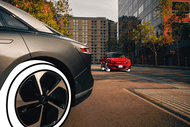
Auto Tips & Advice
The basics on EV tires: why do electric cars need special tires?
When it comes to maintaining your electric vehicle or plug-in hybrid, what replacement tires you choose deserves special attention. Characteristics unique to EVs – namely their heavier weight and how an electric motor functions – cast tires in an outsized role regarding both efficiency and the driving experience of an electric car. In fact, EVs exert more stress on tires, consuming them faster compared to a gas-powered vehicle.
Such factors make the choice of tires for an electric vehicle an important one, and a subject area in which Michelin excels. Long before the advent of electric cars, we were at the forefront of producing high-efficiency premium tires that are made to last. This know-how has positioned Michelin to design and manufacture vehicle tires optimally suited to the unique characteristics of electric vehicles. Understanding what sets EVs apart and how that impacts choosing replacement tires is the best way to explain what an EV tire needs to offer.
Heavy duty
Electric cars have heavy batteries, so they need tires that can carry the extra weight. While the battery stores the energy, it’s the electric motor that provides the instant torque (and no sound inside the car!). With an electric vehicle, as soon as you press the accelerator, you immediately deploy 100% of the vehicle’s power. This means weight transfers are sharper and a lot more intense than with a combustion-powered vehicle. This also affects the impact of wear and tear on the tires.
Michelin tires take this into account in the structure of the tires and its materials.
Think EV versus ICE, the acronym for cars with internal combustible engines, and everyone immediately jumps to “no gas!” And while the eco-friendly design of an electric vehicle eliminates the need for fossil fuels and many other high wear-and-tear engine parts, an EV is nevertheless heavier than an ICE. That greater weight comes from the heavy batteries EVs rely on as their fuel source and is one of the primary reasons EVs perform better with special tires for electric cars.
A heavier vehicle requires a tire that can perform well under more weight and also offers durability and a long tread life. Michelin uses advanced construction techniques combined with stronger materials to strengthen the tire carcass, the tire’s backbone. When combined with more robust compounds used in a tire’s tread, the result is an EV ready tire that provides high durability and excellent wear, on par with the tire lifecycle on a gas-powered vehicle.
Torqued to drive
One of the wow factors in the EV driving experience is its high instant torque and how it accelerates so quickly. Speeding up in an ICE takes longer as pushing on the gas pedal sets off a whole range of functions that need time to work their way to the wheel axles. Whereas in an EV, press on the accelerator, and off you go. There is no time lag from a driveshaft, gears or the engine to attain high speeds and maximum torque. Instead, the power from the motor is directly transferred to the wheels, with some premium electric cars accelerating from 0 to 60 mph in 2.5 seconds.
As thrilling as instant torque is, even a priority for EV owners wanting precision handling and performance, that higher torque is hard on tires. Like with weight, tires for electric cars designed for optimal durability can stand up to the extra stress of high torque. Michelin has invested a great deal of research and development in optimizing vehicle tires to handle the instant torque of electric cars. Similar to weight, a strong tire carcass and tire compounding are key factors and areas Michelin has pioneered for decades. Currently, our focus is on combining compounds for different areas of a tire’s tread pattern and various surfaces of the tire, both inside and out, to meet the elevated tire wear from an EV’s high torque.
Get a grip
Heavier electric vehicles are not only hard on tires, they also have a longer braking distance. All that momentum from the weight, plus the fast acceleration of instant torque, requires a tire with exceptional grip. Here again, Michelin’s deep foundation of expertise in rubber compounds and grip additives has led to the development of EV ready tires offering the ultimate in traction and excellent wet and dry braking. Michelin is a leader in tire technology for enhancing a tire’s wet and dry grip, such as through both symmetric and asymmetric tread patterns, extreme silica+ tread compounds and 360-degree variable sipe technology.
Speaking of putting on the brakes, an EV’s regenerative braking is another factor to consider when understanding why EVs need specific tires. An electric vehicle is designed to capture some of the energy generated during braking. When a driver takes their foot off the accelerator at higher speeds, an ICE vehicle will simply coast whereas an EV will implement regenerative braking when not accelerating. The frequency of regenerative braking varies across EVs but always involves the tires, and accordingly, tire wear.
RR and R: rolling resistance and range
One subject you often hear about related to tires for electric vehicles is rolling resistance. Tires for all vehicles need minimal rolling resistance to be fuel-efficient and eco-friendly.
Fitting your EV with suitable tires ensures you get optimal battery range.
How do tires improve range? Keep in mind that to move an object, you need to give it energy. And between the energy it receives and the energy it gives back in the form of movement, there is always some loss, dissipated as heat, because the tire must relay some energy to the ground. This is called rolling resistance.
Rolling resistance, also called rolling friction, is the force resisting motion when a tire rolls on a surface. Gas-powered vehicles use more fuel to offset rolling resistance whereas electric vehicles use more battery power, impacting an EV’s range on a single charge.
Electric cars are so much more efficient than ICE vehicles because they do not waste a lot of energy through heat loss and engine friction. Thus, the relatively small amount of energy they lose to rolling resistance plays a much more significant role in an EV’s power-loss profile.
Michelin has long been a market leader in developing the fuel efficiency of its tires through technologies that minimize rolling resistance, such as tire compounds and exclusive tread design. This expertise is now more important than ever when it comes to EV-specific tires and the need to limit energy loss through tire deformation. Choosing a tire where the rolling resistance has been engineered down to a minimum will greatly enhance your vehicle’s overall efficiency and deliver a long-lasting drive.
The sound of noise
The other big difference in tires optimized for electric vehicles is how they contribute to a quiet, comfortable ride. That might seem counterintuitive. EVs are known for being so quiet compared to their gas-powered relatives. However, those noisy engines actually also mask the noise created when driving down the street. While in the quiet of an EV, there are few additional sounds to block out the cacophony of road and tire noise.
EV Ready tires have been designed to reduce noise levels transferred to the passenger cabin through acoustic dampening foam and tread design. Some Michelin tire lines reduce cabin noise by 20 percent*, thanks to Michelin Acoustic Technology, a vibration-absorbent polyurethane foam ring inside the tire. Michelin-developed PIANO noise reduction technology also plays an important part by tuning the shape of the tread blocks and tire grooves to tune out unwanted frequencies from the tire's noise profile.
Identify your priorities: range, noise, wear or traction
Ultimately, the choice of tires for an EV involves setting your priorities. Are you concerned about range and an extended drive? Then a tire optimized for low rolling resistance will get you farther on a single charge, such as Michelin Primacy tires. Looking for an unmatched driving experience with a quiet and comfortable ride? Our Pilot EV tires have been engineered to deliver performance without the noise.
If tire wear is your biggest concern, you’ll want a tire made to last, such as the Michelin Defender line. Some EV owners are more concerned about safety and traction, especially if they live in wintery climates. Proven all-season performance tires like the Michelin CrossClimate2 gives drivers confidence in any weather, offering superior stopping power and excellent wet and dry braking, or even special winter tires, such as the Michelin-X Ice Snow tire.
One of the decisions EV owners face when shopping replacement tires for their electric car is whether or not to stay with OE tires, the original equipment tires designed for their vehicle. And while OE tires have been optimized for a particular vehicle and offer many advantages, the choice of a replacement tire ultimately comes down to the vehicle owner’s priorities. Knowing what is important to you for your driving experience — range, noise, wear or traction — can help you best determine the right tire for your electric vehicle.
Which Michelin tires should I choose for my electric car?
While Michelin tires are suitable for EVs, some respond to specific driving demands.
- A driver of a sports car wants fast acceleration, great torque transmission and high precision at the steering wheel. If you are such a driver, then Michelin Pilot Sport family, specifically designed for these needs, is a great choice for you.
- A driver of a sedan is more likely to prioritize safety and driving comfort for peace of mind. If you can relate to this profile, then the Michelin CrossClimate2 is designed for drivers like you.
- For a smooth, quiet ride designed to outlast, opt for the Defender family.
- Depending on where you live, some EVs also require Winter tires for reliable grip and traction in snow, ice and extreme winter conditions.
- To get the most miles from your fuel tank or range from your EV batteries, combined with low noise for a quiet, comfortable ride, seek the Primacy family of tires.
For more information, click on the tires below

MICHELIN Pilot Sport EV
Efficiency


Electrified road control made to last
View this tire

MICHELIN Primacy Tour A/S
Efficiency
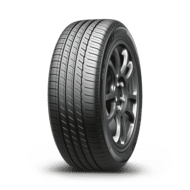

The perfect match to get the relaxing driving experience you expect from your premium vehicle.
View this tire

MICHELIN Primacy All Season
Efficiency
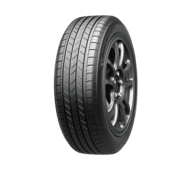

Developed to meet the demanding standards of top vehicle manufacturers, the Michelin Primacy All Season tire is the latest generation of fuel-efficient, all-season performance.
View this tire

MICHELIN Primacy LTX
Efficiency
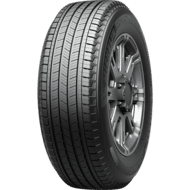

Developed in conjunction with the world's leading truckmakers, the Michelin Primacy LTX is ideally suited for drivers looking to maximize fuel efficiency with a quiet and comfortable ride.
View this tire

MICHELIN Primacy XC
Efficiency
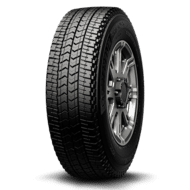

Developed in conjunction with the world's leading truckmakers, Michelin launched the Michelin Primacy XC tire to deliver not only light All-Terrain performance, but also a quiet and comfortable ride on-road and excellent fuel efficiency.
View this tire

MICHELIN Primacy MXM4
Efficiency
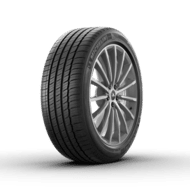

360 degrees of ultimate satisfaction for the premium car owner who wants it all: good wet braking, precise handling, refined ride quality, and all-season safety. Comfortable driving without compromising control.
View this tire

MICHELIN Energy™ Saver All Season
Efficiency
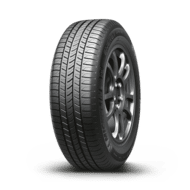

Our ultimate fuel-efficient passenger car tire is ideally suited for drivers looking to maximize fuel economy without compromising long treadlife and all season safety.
View this tire
How do I maximize the life of my EV tires?
As for any other tires, there are two main ways you can protect your EV tires and thereby optimize their lifetime: maintenance and driving style.
EV tire maintenance involves monitoring the pressure, alignment and wear. The pressure should be adapted depending on the load being carried. But how do you find out the ideal tire pressure? It’s simple! Cars feature a sticker from the manufacturer, often inside the driver’s door or fuel cap, which indicates the recommended pressure for specific tire sizes. There are also recommendations according to whether the car is loaded or not.
Eco-driving is an expression we hear more and more these days and with good reason. With the objective of reducing energy consumption, the right driving style not only maximizes the range of an electric vehicle but it also optimizes tire quality and performance.
EV tire technology is part of Michelin’s DNA
Michelin's decades of innovation in tires has positioned us to deliver technologies aligned with your priorities for EV tires. Michelin tires are EV ready, thanks to our 30-plus years of innovation in tire wear, tire noise reduction and low rolling resistance. In this new era of mobility where electric vehicles are reshaping what a tire needs to deliver, Michelin is already ahead of the curve and well positioned to offer the optimal tire for electric vehicles.
For more facts and figures about EV tires, visit our FAQ page or our EV Tires page with links to in-depth articles about electric cars and tires. Use the Tire Selector module here below to start shopping for the right tire for your vehicle or visit the Shop EV Tires page for an overview of Michelin’s EV ready tires.
Find the perfect tire
Enter your vehicle or tire size
We're searching for your tire...
Wait few seconds we're processing your photo

Find tire dealers near you in seconds
Search by
Address, City or ZIP code
Car
-
Car
-
Motorbike
Top 5 cities in the United States
Legal Mention
*Internal noise measurement, done in 2016 on size 245/45 R19 on KIA Cadenza. Noise level measured on the range "170-230Hz". Results may vary according to vehicle, tire range and size, speed, and road conditions.

